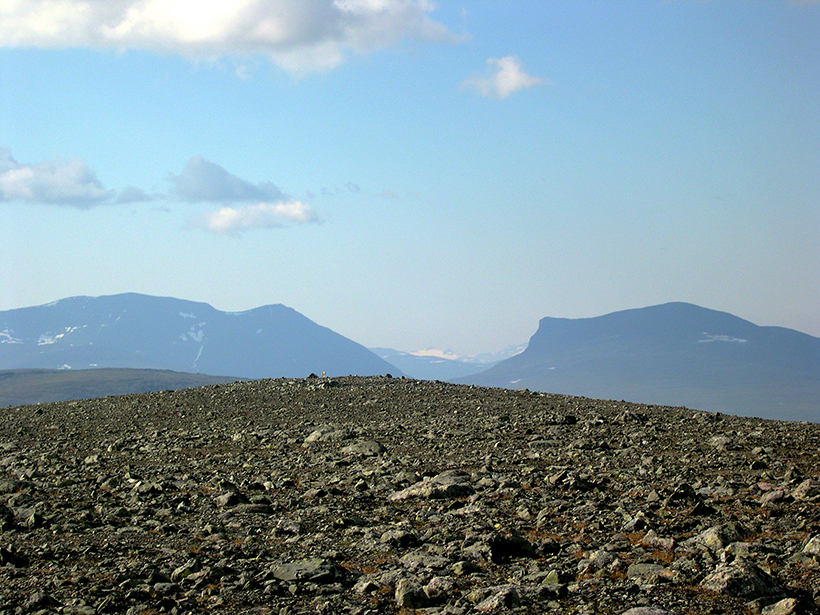Galactic cosmic rays continually bombard Earth’s upper atmosphere, causing a cascade of secondary particle fluxes. The more energetic components of this particle cascade penetrate the atmosphere and interact with the nuclear building blocks within the minerals that compose the rocks on Earth’s surface, producing a wide variety of secondary nuclides.
Cosmogenic radionuclides provide scientists with a means to quantify the scales of processes and interactions that shape our planet.
Because some of these nuclides are rarely produced by terrestrial processes, a few long-lived cosmic ray–produced (cosmogenic) radionuclides with half-lives ranging from 0.3 to 1.4 million years, including chlorine-36 (36Cl), aluminum-26 (26Al), and beryllium-10 (10Be), can be detected by accelerator mass spectrometry (AMS). The concentrations of these cosmogenic radionuclides provide scientists with a means to quantify the spatial and temporal scales of climatic, tectonic, and geomorphic processes and interactions that shape our planet.
Cosmogenic nuclide analysis is a technique whose application to Earth sciences began in the late 20th century. It represents a significant analytical advance in the study of landscape evolution and in establishing how long a surface has been exposed to cosmic rays; that is, how long a current surface has been on the surface.
The Third Nordic Workshop on Cosmogenic Nuclide Techniques commemorated the 30-year publication anniversary of the first series of studies in 1986 that demonstrated the potential of cosmogenic nuclide analysis in understanding Earth surface processes. The meeting drew more than 70 participants from 15 countries.
New Capabilities Produce New Insights
Cosmogenic nuclide research was made possible by the development of new sample preparation methods coupled with increased efficiencies and capabilities of AMS, an analytical technique with unprecedented sensitivity. These advances enable scientists to measure minuscule concentrations of terrestrially produced cosmogenic radionuclides.
Cosmogenic nuclide analyses have produced paradigm shifts in the prevailing concepts and models of planet Earth.
The first proof-of-concept publications on this technique began to appear in the early to mid-1980s, and they covered studies on a range of cosmogenic isotopes (helium-3, 10Be, 26Al, 36Cl, and neon-21) in a variety of natural archives. Since then, cosmogenic nuclide analyses have produced paradigm shifts in the prevailing concepts and models of planet Earth, geologic and biologic, past and present. Today, the cosmogenic nuclide technique is an indispensable method within the geosciences tool kit.
Taking Stock and Moving Ahead
Sessions at the meeting were structured around four themes: radionuclide production rates and scaling factors, applications and modeling using multiple cosmogenic nuclides, landscape evolution in formerly glaciated regions, and global erosion rates and mass wasting.

Highlights of the meeting included discussions on differences among models to calculate scaling schemes; current status and future plans for international initiatives for Web-based site-specific production rate calculators (including Cosmic-Ray Produced Nuclide Systematics, or CRONUS); and various aspects connecting paleoclimate change, glacial chronologies, and average erosion rates.
A number of Nordic researchers gave talks highlighting their advances in applying multiple cosmogenic radioisotopes and noble gas isotopes to unravel the history of changes in long-term landscape evolution. Long-standing debates on the evolution of formerly glaciated passive margins, landscape features with complex histories of burial and exposure, may now be resolved using a combination of numerical landscape modeling and statistical evaluations of cosmogenic isotope data using Monte Carlo methods.
The meeting concluded with a productive discussion of ways to improve data quality and reproducibility by calling on the AMS community to systematically engage in a program of continual interlaboratory comparisons. We expect significant advances in AMS precision and techniques, and we are confident that the next 30 years will be as exciting and rewarding as the past 30 years.
This conference was supported by Stockholm University and the Swedish Nuclear Fuel and Waste Management Company.
—Arjen P. Stroeven (email: [email protected]; @AStroeven), Geomorphology and Glaciology, Department of Physical Geography, Stockholm University, Sweden; David Fink, Australian Nuclear Science and Technology Organisation, Sydney; and Marc Caffee, PrimeLab, Purdue University, West Lafayette, Ind.
Citation:
Stroeven, A. P.,Fink, D., and Caffee, M. (2016), Deciphering the cosmogenic code to learn Earth’s surface history, Eos, 97, https://doi.org/10.1029/2016EO062975. Published on 28 November 2016.
Text © 2016. The authors. CC BY-NC-ND 3.0
Except where otherwise noted, images are subject to copyright. Any reuse without express permission from the copyright owner is prohibited.

